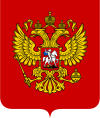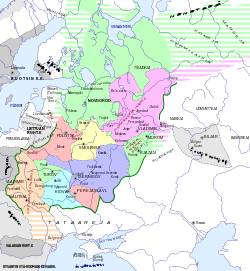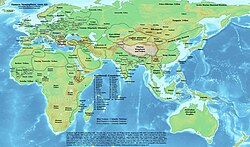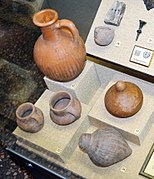Поволшка Бугарска — разлика између измена
м Бот: по захтеву Садка; козметичке измене |
. |
||
| Ред 1: | Ред 1: | ||
{{Short description|Бугарска држава 800-1200-их на реци Волги}} |
|||
{{Историја Русије}} |
{{Историја Русије}} |
||
'''Поволшка''' или '''Волшка Бугарска''' ({{јез-рус|Волжская Булгария}}), односно '''Волшко-Камска Бугарска''' ({{јез-рус|Волжско-Камская Булгария}}), или '''Итилска Бугарска''' ({{јез-тат|Идел Болгар}}; {{јез-чув|Атӑлçи́ Пӑлха́р}}), била је [[Средњи век|средњовјековна]] [[Прабугари|прабугарска]] [[држава]] која је од 7. до 13. вијека постојала око [[Ушће|ушћа]] ријеке [[Кама (река)|Каме]] у [[Волга|Волгу]] у данашњој [[Русија|Русији]].<ref>{{Cite book|last=Nicolle|first=David|title=Armies of the Volga Bulgars & Khanate of Kazan|year=2013|pages=14}}</ref><ref>{{Cite book|last=Champion|first=Timothy|title=Nationalism and Archaeology in Europe|year=2014|pages=227| |
'''Поволшка''' или '''Волшка Бугарска''' ({{јез-рус|Волжская Булгария}}), односно '''Волшко-Камска Бугарска''' ({{јез-рус|Волжско-Камская Булгария}}), или '''Итилска Бугарска''' ({{јез-тат|Идел Болгар}}; {{јез-чув|Атӑлçи́ Пӑлха́р}}), била је [[Средњи век|средњовјековна]] [[Прабугари|прабугарска]] [[држава]] која је од 7. до 13. вијека постојала око [[Ушће|ушћа]] ријеке [[Кама (река)|Каме]] у [[Волга|Волгу]] у данашњој [[Русија|Русији]].<ref>{{Cite book|last=Nicolle|first=David|title=Armies of the Volga Bulgars & Khanate of Kazan|year=2013|pages=14}}</ref><ref>{{Cite book|last=Champion|first=Timothy|title=Nationalism and Archaeology in Europe|year=2014|pages=227|url=https://books.google.se/books?id=obwbBQAAQBAJ&pg=PT199&lpg=PT199&dq=volga+bulgaria+tatar&source=bl&ots=TY1NtZ9eXD&sig=YlLdSr8cSFiDwjKLDJuuLo1Y3aE&hl=sv&sa=X&ei=sEC9VLTYJOWfyAPL74CAAw&ved=0CG8Q6AEwCQ#v=onepage&q=volga%20bulgaria%20tatar&f=false}}</ref><ref>{{Cite book|last=Koesel|first=Karrie J.|title=Religion and Authoritarianism: Cooperation, Conflict, and the Consequences|year=2014|ref=https://books.google.se/books?id=OcKfAgAAQBAJ&pg=PA103&lpg=PA103&dq=volga+bulgaria+tatar&source=bl&ots=RTcNZ26Elq&sig=lPipv1HlcrY8jYxOuGmSaMfWqQA&hl=sv&sa=X&ei=DUS9VIGvKIbaywOCroGYCw&ved=0CFwQ6AEwDDgK#v=onepage&q=volga%20bulgaria%20tatar&f=false|pages=103}}</ref> Својеврсни данашњи насљедници Поволшке Бугарске су [[Татарстан]] и [[Чувашија]], републике у саставу данашње [[Русија|Руске Федерације]]. |
||
== Настанак == |
== Настанак == |
||
| Ред 42: | Ред 44: | ||
== Референце == |
== Референце == |
||
{{reflist| |
{{reflist|}} |
||
== Литература == |
== Литература == |
||
{{refbegin|30em}} |
|||
| ⚫ | * {{Cite book|ref=harv|last= |
||
* {{Cite book|ref=harv|last= |
* {{Cite book|ref=harv|last=Koesel|first=Karrie J.|title=Religion and Authoritarianism: Cooperation, Conflict, and the Consequences|year=2014|url=https://books.google.se/books?id=OcKfAgAAQBAJ&pg=PA103&lpg=PA103&dq=volga+bulgaria+tatar&source=bl&ots=RTcNZ26Elq&sig=lPipv1HlcrY8jYxOuGmSaMfWqQA&hl=sv&sa=X&ei=DUS9VIGvKIbaywOCroGYCw&ved=0CFwQ6AEwDDgK#v=onepage&q=volga%20bulgaria%20tatar&f=false|pages=103}} |
||
| ⚫ | * {{Cite book|ref=harv|last=Champion|first=Timothy|title=Nationalism and Archaeology in Europe|year=2014|pages=227|url=https://books.google.se/books?id=obwbBQAAQBAJ&pg=PT199&lpg=PT199&dq=volga+bulgaria+tatar&source=bl&ots=TY1NtZ9eXD&sig=YlLdSr8cSFiDwjKLDJuuLo1Y3aE&hl=sv&sa=X&ei=sEC9VLTYJOWfyAPL74CAAw&ved=0CG8Q6AEwCQ#v=onepage&q=volga%20bulgaria%20tatar&f=false}} |
||
* {{Cite book|ref=harv|last=Nicolle|first=David|title=Armies of the Volga Bulgars & Khanate of Kazan|year=2013|pages=14}} |
* {{Cite book|ref=harv|last=Nicolle|first=David|title=Armies of the Volga Bulgars & Khanate of Kazan|year=2013|pages=14}} |
||
* Southeastern Europe in the Middle Ages, 500-1250, Florin Curta, Cambridge University Press, 2006, {{ISBN|0521815398}} |
|||
* {{Cite book|last=Charles|first=Robert H.|author-link=Robert Charles (scholar)|title=The Chronicle of John, Bishop of Nikiu: Translated from Zotenberg's Ethiopic Text|year=2007|orig-year=1916|location=Merchantville, NJ|publisher=Evolution Publishing|isbn=9781889758879|url=https://books.google.com/books?id=KgZ-DOr77OQC}} |
|||
* {{Cite book|last=Ostrogorsky|first=George|author-link=George Ostrogorsky|year=1956|title=History of the Byzantine State|location=Oxford|publisher=Basil Blackwell|url=https://books.google.com/books?id=Bt0_AAAAYAAJ}} |
|||
* {{cite web |first= Dilian|last= Gurov |date= March 2007 |title= The Origins of the Bulgars |url= https://www.nada.kth.se/~dilian/bulgars.pdf |pages= }} |
|||
* {{cite book |author= Leif Inge Ree Petersen |date= 2013|title= Siege Warfare and Military Organization in the Successor States (400-800 AD): Byzantium, the West and Islam|url= https://books.google.com/books?id=BRGaAAAAQBAJ |publisher= Brill|pages= 369 |isbn= 9789004254466}} |
|||
* Rasho Rashev, ''Die Protobulgaren im 5.-7. Jahrhundert'', Orbel, Sofia, 2005 |
|||
* Mingazov S. Kubrat - the Ruler of Great Bulgaria and Ketrades - character of John of Nikiu work - Kazan: Institute of History of Academy of Science of Republic of Tatarstan, 2012 |
|||
* [http://philology-and-culture.kpfu.ru/?q=system/files/39_0.pdf Mingazov S. The Heirs of Great Bulgaria in Western Europe// Philology and Culture. - 2012. - No. 1 (27).- S. 201-207.] |
|||
* [https://books.google.com/books?id=_-G1L-9Zec0C&q=old+great+Bulgaria+&pg=PA104 The Other Europe in the Middle Ages: Avars, Bulgars, Khazars, and Cumans, Florin Curta, BRILL, 2008], {{ISBN|9004163891}} |
|||
* {{cite book | last = Diaconis | first = Paulus | author-link = Paul the Deacon | title = Historia Langobardorum | date = 787 | location = Monte Cassino, Italy | url = http://www.northvegr.org/lore/langobard/033.php | no-pp = true | page = Book V chapter 29 | access-date = 2012-08-07 | archive-url = https://web.archive.org/web/20080517112407/http://www.northvegr.org/lore/langobard/033.php | archive-date = 2008-05-17 | url-status = dead }} |
|||
* {{cite journal|title=Sepolture Con Cavallo Da Vicenne (Cb)|journal=I° Congresso Nazionale di Archeologia Medievale.|year=2001|first=Bruno|last=Genito|url=http://192.167.112.135/NewPages/COLLANE/TESTISAMI/SAMI1/48.PDF|access-date=2007-09-27|archive-url=https://web.archive.org/web/20060602175209/http://192.167.112.135/NewPages/COLLANE/TESTISAMI/SAMI1/48.PDF|archive-date=June 2, 2006|url-status=dead}} |
|||
* {{cite journal|title=Anthropological and cultural features of a skeletal sample of horsemen from the medieval necropolis of Vicenne-Campochiaro (Molise, Italy)|journal=Collegium Antropologicum|year=2001|first=M. G.|last=Belcastro|author2=Faccini F.|volume=25|issue=2|pages=387–401|pmid=11811269|url=http://www.collantropol.hr/_doc/Coll.%20Antropol.%2025%20(2001)%202:%20387%E2%80%93401.pdf|access-date=2007-09-27|url-status=dead|archive-url=https://web.archive.org/web/20090227090628/http://www.collantropol.hr/_doc/Coll.%20Antropol.%2025%20(2001)%202:%20387%E2%80%93401.pdf|archive-date=2009-02-27}} |
|||
* {{cite web |url=http://www.italia.it/it/guide/5,en,SCH1/objectId,SIG56921Pit,curr,EUR,parentId,RGN21it,season,at1,selectedEntry,artculture/intern.html |title=Longobard necropolis of Campochiaro |access-date=2007-09-27 |archive-url=https://web.archive.org/web/20071106041902/http://www.italia.it/it/guide/5,en,SCH1/objectId,SIG56921Pit,curr,EUR,parentId,RGN21it,season,at1,selectedEntry,artculture/intern.html |archive-date=November 6, 2007 |url-status=dead }} |
|||
* Conte Miltenova, N. - I Bulgari di [[Gallo Matese]] - Prefazione e postfazione di Giuseppe Mario Tufarulo Passaporto Editore, Roma, 1993. - C.N.R. |
|||
* [http://www.promacedonia.org/vz1a/vz1a_b1_1.html Васил Н. Златарски. История на Първото българско Царство. Епоха на хуно-българското надмощие с. 188.] |
|||
* {{cite book |last=Runciman |first=Steven |author-link=Steven Runciman |date=1930 |chapter=§ Appendix V – Bulgar titles |title=A history of the First Bulgarian Empire |chapter-url=http://macedonia.kroraina.com/en/sr/sr_app5.htm |work=macedonia.kroraina.com |publisher=[[George Bell & Sons]] |place=London }} |
|||
* {{citation |last=Maenchen-Helfen |first=Otto John |author-link=Otto J. Maenchen-Helfen |date=1973 |title=The World of the Huns: Studies in Their History and Culture |url=https://books.google.com/books?id=CrUdgzSICxcC |publisher=University of California Press |isbn=9780520015968 }} |
|||
* {{cite book |last=Tokarev |first=Sergei A. |author-link=Sergei Aleksandrovich Tokarev |date=1980 |title=Mify narodov mira |trans-title=Myths of the world's peoples |language=ru |publisher=Sovetskaya Entsiklopediya |place=Moscow |volume=2}} |
|||
* {{cite book |last=Shnirelʹman |first=Viktor A. |date=1987 |chapter=The Rivalry for the Bulgar legacy |title=Who Gets the Past?: Competition for Ancestors Among Non-Russian Intellectuals in Russia |chapter-url=https://books.google.com/books?id=4iwHp8amsdEC |publisher=Woodrow Wilson Center Press |isbn=9780801852213 |ref={{harvid|Shnirelʹman1996}}}} |
|||
* {{cite book |last=Fine |first=John V. Antwerp |author-link=John Van Antwerp Fine Jr. |title=The Early Medieval Balkans: A Critical Survey from the Sixth to the Late Twelfth Century |url=https://books.google.com/books?id=Y0NBxG9Id58C |publisher=University of Michigan Press |year=1991 |isbn=9780472081493 }} |
|||
* {{cite book |last=Golden |first=Peter Benjamin |author-link=Peter Benjamin Golden |date=1992 |title=An introduction to the History of the Turkic peoples: ethnogenesis and state formation in medieval and early modern Eurasia and the Middle East |url=https://www.academia.edu/12545004 |publisher=[[Harrassowitz Verlag|Otto Harrassowitz]] |place=[[Wiesbaden]] |isbn=9783447032742 }} |
|||
* {{cite book |last1=Olson |first1=James S. |author-link=James S. Olson |last2=Pappas |first2=Lee Brigance |last3=Pappas |first3=Nicholas Charles |date=1994 |title=An Ethnohistorical Dictionary of the Russian and Soviet Empires |url=https://books.google.com/books?id=CquTz6ps5YgC |publisher=[[Greenwood Publishing Group]] |isbn=9780313274978 |ref={{harvid|Olson, Pappas, Pappas1994}}}} |
|||
* {{cite book |last1=Bowersock |first1=Glen |author-link1=Glen Bowersock |last2=Brown |first2=Peter |author-link2=Peter Brown (historian) |last3=Grabar |first3=Oleg |author-link3=Oleg Grabar |date=1999 |title=Late Antiquity: A Guide to the Postclassical World |url=https://archive.org/details/lateantiquitygui00bowe |url-access=registration |publisher=Harvard University Press |isbn=9780674511736 |ref={{harvid|Bowersock, Brown, Grabar1999}}}} |
|||
* {{cite book |last=Croke |first=Brian |date=2001 |title=Count Marcellinus and His Chronicle |url=https://books.google.com/books?id=ep6U-meRt00C |publisher=Oxford University Press |isbn=9780198150015 }} |
|||
* {{cite book |last=Karatay |first=Osman |date=2003 |title=In Search of the Lost Tribe: The Origins and Making of the Croatian Nation |url=https://books.google.com/books?id=h_Qu1ywX0-wC |publisher=Ayse Demiral |isbn=9789756467077 }} |
|||
* {{cite book |last=Vásáry |first=István |date=2005 |title=Cumans and Tatars: Oriental Military in the Pre-Ottoman Balkans, 1185–1365 |url=https://books.google.com/books?id=7DJWyg97IggC |publisher=Cambridge University Press |isbn=9781139444088 }} |
|||
* {{cite book |last=Curta |first=Florin |author-link=Florin Curta |date=2006 |title=Southeastern Europe in the Middle Ages, 500–1250 |url=https://archive.org/details/southeasterneuro0000curt |url-access=registration |publisher=Cambridge University Press |isbn=9780521815390 }} |
|||
* {{cite book |last1=Waldman |first1=Carl |last2=Mason |first2=Catherine |date=2006 |title=Encyclopedia of European Peoples |url=https://books.google.com/books?id=kfv6HKXErqAC |publisher=Infobase Publishing |isbn=9781438129181 |ref={{harvid|Waldman, Mason2006}}}} |
|||
* {{cite book |last=Brook |first=Kevin Alan |date=2006 |title=The Jews of Khazaria |url=https://books.google.com/books?id=hEuIveNl9kcC |publisher=[[Rowman & Littlefield|Rowman & Littlefield Publishers]] |isbn=1442203021 }} |
|||
* {{cite book |first=Kiril |last=Petkov |date=2008 |title=The Voices of Medieval Bulgaria, Seventh-Fifteenth Century: The Records of a Bygone Culture |url=https://books.google.com/books?id=tjPEtxSOuYgC |publisher=Brill |isbn=9789004168312 }} |
|||
* {{cite book |last=Fiedler |first=Uwe |chapter=Bulgars in the Lower Danube region: A survey of the archaeological evidence and of the state of current research |title=The Other Europe in the Middle Ages: Avars, Bulgars, Khazars and Cumans |chapter-url=https://books.google.com/books?id=_-G1L-9Zec0C |editor-last1=Curta |editor-first1=Florin |editor-link1=Florin Curta |editor-last2=Kovalev |editor-first2=Roman |date=2008 |publisher=Brill |pages=151–236 |isbn=9789004163898 }} |
|||
* {{Cite book |last=Sophoulis |first=Panos |date=2011 |title=Byzantium and Bulgaria, 775–831 |url=https://books.google.com/books?id=EbIyAQAAQBAJ |publisher=Brill |isbn=9789004206960 |access-date=2015-05-14 |archive-url=https://web.archive.org/web/20150518083412/https://books.google.hr/books?id=EbIyAQAAQBAJ |archive-date=2015-05-18 |url-status=dead }} |
|||
* {{cite book |last=Sedlar |first=Jean W. |date=2011 |title=East Central Europe in the Middle Ages, 1000–1500 |url=https://books.google.com/books?id=ANdbpi1WAIQC |publisher=University of Washington Press |isbn=9780295800646 }} |
|||
* {{cite book |last=Golden |first=Peter B. |author-link=Peter Benjamin Golden |date=2011 |title=Studies on the Peoples and Cultures of the Eurasian Steppes |url=https://www.academia.edu/9609971 |publisher=Editura Academiei Române; Editura Istros a Muzeului Brăilei |isbn=9789732721520 }} |
|||
* {{cite book |last=Chen |first=Sanping |date=2012 |title=Multicultural China in the Early Middle Ages |url=https://books.google.com/books?id=ugbWH-5OjegC |publisher=University of Pennsylvania Press |isbn=978-0812206289 }} |
|||
* {{citation |last=Golden |first=Peter B. |author-link=Peter Benjamin Golden |title=Oq and Oğur~Oğuz* |publisher=Turkish and Middle Eastern Studies, Rutgers University |year=2012 |url=http://www.enu.kz/repository/repository2014/oq-and-ogur.pdf |access-date=2015-04-13 |archive-url=https://web.archive.org/web/20150419023615/http://www.enu.kz/repository/repository2014/oq-and-ogur.pdf |archive-date=2015-04-19 |url-status=dead }} |
|||
* {{cite book |last=Curta |first=Florin |author-link=Florin Curta |chapter=Avar Blitzkrieg, Slavic and Bulgar raiders, and Roman special ops: mobile warriors in the 6th-century Balkans |title=Eurasia in the Middle Ages. Studies in Honour of Peter B. Golden |chapter-url=https://www.academia.edu/12138833 |editor1=Zimonyi István |editor2=Osman Karatay |date=2015 |publisher=Otto Harrassowitz |place=Wiesbaden |pages=69–89 }} |
|||
* {{cite journal |pages=941–647 |doi=10.1098/rspb.2004.2698 |title=Unravelling migrations in the steppe: Mitochondrial DNA sequences from ancient Central Asians |pmc=1691686 |year=2004 |last1=Lalueza-Fox |first1=C. |last2=Sampietro |first2=M. L. |last3=Gilbert |first3=M. T. P. |last4=Castri |first4=L. |last5=Facchini |first5=F. |last6=Pettener |first6=D. |last7=Bertranpetit |first7=J. |journal=Proceedings of the Royal Society B: Biological Sciences |volume=271 |issue=1542 |pmid=15255049 |ref={{harvid|Lalueza-Fox, et al.2004}}}} |
|||
* {{cite journal |doi=10.1371/journal.pone.0056779 |pmc=3590186 |title=Y-Chromosome Diversity in Modern Bulgarians: New Clues about Their Ancestry |year=2015 |last1=Karachanak |first1=S. |last2=Grugni |first2=V. |last3=Fornarino |first3=S. |last4=Nesheva |first4=D. |last5=Al-Zahery |first5=N. |last6=Battaglia |first6=V. |last7=Carrosa |first7=C. |last8=Yordanov |first8=Y. |last9=Torroni |first9=A. |last10=Galabov |first10=A. |last11=Toncheva |first11=D. |last12=Semino |first12=O. |journal=PLOS ONE |volume=8 |issue=3 |ref={{harvid|Karachanak, et al.2013}} |pmid=23483890 |pages=e56779|bibcode=2013PLoSO...856779K |doi-access=free }} |
|||
* {{cite book|last= Zimonyi|first= István|title= The Origins of the Volga Bulghars|series= Studia Uralo-Altaica, 32|editor= Klára Szõnyi-Sándor|year= 1990}} |
|||
{{refend}} |
|||
== Спољашње везе == |
== Спољашње везе == |
||
{{ |
{{Commons category|Volga Bulgaria}} |
||
* {{ru icon}} Bariev, R(iza) X. 2005. [https://web.archive.org/web/20140614144412/http://www.bulgarizdat.ru/articles.shtml#bi02 ''Волжские Булгары : история и культура''] (Volga Bulgars: History and Culture). Saint Petersburg: Agat. |
* {{ru icon}} Bariev, R(iza) X. 2005. [https://web.archive.org/web/20140614144412/http://www.bulgarizdat.ru/articles.shtml#bi02 ''Волжские Булгары : история и культура''] (Volga Bulgars: History and Culture). Saint Petersburg: Agat. |
||
* {{cite EB1911 |wstitle = Bulgaria, Eastern |volume= 4 |last= Kropotkin |first= Peter Alexeivitch |author-link= Peter Kropotkin| page = 786 |short=1}} |
|||
* [http://www.kroraina.com/p_bulgar/p_bulg5.htm Old Great Bulgaria - facts and sources] |
|||
* [http://kroraina.com/macedon/mikul.html Ivan Mikulčić, ''Towns and castles in medieval Macedonia'', Makedonska civilizacija, Skopje, 1996] (in Macedonian) |
|||
* [https://web.archive.org/web/20100604083401/https://www.mnsu.edu/emuseum/cultural/oldworld/europe/bulgaria.html The Bulgarians, Minnesota State University] |
|||
{{Нормативна контрола}} |
{{Нормативна контрола}} |
||
Верзија на датум 7. јул 2023. у 06:03
| Овај чланак је део серије о историји Русије |
| Историја Русије |
|---|
 |
Поволшка или Волшка Бугарска (рус. Волжская Булгария), односно Волшко-Камска Бугарска (рус. Волжско-Камская Булгария), или Итилска Бугарска (тат. Идел Болгар; чув. Атӑлçи́ Пӑлха́р), била је средњовјековна прабугарска држава која је од 7. до 13. вијека постојала око ушћа ријеке Каме у Волгу у данашњој Русији.[1][2][3] Својеврсни данашњи насљедници Поволшке Бугарске су Татарстан и Чувашија, републике у саставу данашње Руске Федерације.
Настанак
Изворних података о Поволшкој Бугарској је мало. Аутентични прабугарски записи се нису сачували, па већина података потиче из тадашњих арапских, персијских, индоаријских и руских извора. Нешто је података прикупљено каснијих археолошким ископавањима.
Подручје Поволшке Бугарске су испочетка насељавала угро-финска племена. Прабугари су се тамо преселили из околице данашњег Азова око године 665. Водио их је Котраг, син прабугарског кана Кубрата. У 8. вијеку су населили подручје Идел-Урал (Волга-Урал), те су крајем 9. вијека постали доминантна популација и ујединили различита племена која су живјела на том подручју.[4] Дио прабугарских племена се, пак, населио даље на запад, односно у Подунављу у данашњој Бугарској, стопивши се са тамошњим словенским становништвом, преузевши јужнословенски језик и православну вјеру те тако створивши модерну бугарску нацију.
Племена на подручју Поволшке Бугарске су се почела удруживати крајем 9. вијека. Подигли су пријестоницу Болгар, смјештену око 160 км јужно од данашњега Казања. Већина историчара сматра да нису били сасвим независни од Хазара, барем до 965. када је Хазаре уништио Свјатослав I Кијевски.
Абу ел-Гази Бахадур је назвао поволшкопрабугарски народ именом Улак.[5]
Успон

Највећи дио становништва Поволжја су чинила туркијска племена, међу којима су били Прабугари, Сувари, Барсили, Билари, Баланџари и дио Буртаса (према ибн Рустаху). Потомци тог дијела Поволшких Прабугара, с већим или мањим примјесама угро-финских и кипчашких туркијских народа су данашњи Чуваши и казански Татари. Мањи дио становништва су чинили угро-финска племена (Есегели и Паскатири) од којих су вјероватно настали данашњи Бесермени и Татари.
Под владавином Алмиша је у 10. вијеку државна религија постао ислам. У државу је године 922/923. абасидски халиф ал-Муктадир послао Ибн Фадлана. Његова мисија је била успоставити дипломатске односе, обучити суце (кадије) и учитеље шеријатског права и помоћи изградњи тврђава и џамија.[6] Упркос увођења ислама, дуже времена се међу Поволшким Прабугарима наставио практиковати тенгризам.
Поволшка Бугарска је била на средњем току Волге, па је зато пред крсташке ратове постала важном рутом и почела доминирати трговином између Европе и Азије. Пријестоница Болгар је постала развијени и богат град, који се по материјалном богатству могао такмичити с највећим средиштима исламског свијета. Главни трговски партнери Поволшких Прабугара су били Викинзи, Бјармија на јужној обали Бијелог мора и сливу Сјеверне Двине, Југра између ријеке Печоре и сјеверног Урала и Ненци. Њихови трговци су путовали до Багдада и Цариграда на југу односно до Кине на истоку.
Друга већа насеља су били Биљар, Сувар, Кашан и Жукотин. Данашњи градови Казањ и Јелабуга су се развили из некадашњих поволшкобугарских тврђава. Нека од поволшкобугарских насеља, спомињаних у руским љетописима, до данас нису откривена. Међу њих спадају Ошељ, Тухчин, Брјахимов и Тав Иле. Неке од њих су приликом најезде потпуно уништили Монголи.
Једина војничка сила која је угрожавала Поволшку Бугарску су биле руске кнежевине на западу. Руси су у 11. вијеку опустошили Поволшку Бугарску, а на пријелазу из 12. у 13. вијека, владари Владимира на челу са Андрејем Богољубским и Всеволдом III, страхујући од поволшкобугарског напада са истока, превентивно напали поволшкобугарска мјеста. Поволшки Прабугари су због тога престоницу премјестили из Болгара у Биљар.
Пропаст


У септембру 1223. је претходница монголске Џингис-канове војске под Субедејем код Самаре прва прешла границу Поволшке Бугарске, али је поражена. Године 1236. су се Монголи вратили и у пет година покорили цијелу државу, која је тада трпила унутрашње сукобе. Поволшка Бугарска је постала дио Џочијевог каната, касније Златне хорде. Подијељена је на неколико кнежевина, које су постали вазали Златне хорде, и имали нешто аутономије. Године 1438. је од једне од њих настао Казањски канат.
Дио историчара вјерује да је током монголске инвазије убијено преко 80% становништва. Преживјели су се повукли на подручје данашмње Чувашије и Татарстана створило неколико држава. Степска подручја Поволшке Бугарске су населили номадски Кипчаци и Монголи, па је због њих дошло до нестанка пољопривреде.
Преживјела поволшкобугарска насеља су касније обновила и постала средишта трговине и у Златној хорди.
Галерија
-
Поволшка Бугарска у Евроазијском свету око 1200. године
-
Грнчарија Поволшке Бугарске, 10—14 вијек
-
Огрлица, Поволшка Бугарска, 10—14 вијек
Референце
- ^ Nicolle, David (2013). Armies of the Volga Bulgars & Khanate of Kazan. стр. 14.
- ^ Champion, Timothy (2014). Nationalism and Archaeology in Europe. стр. 227.
- ^ Koesel, Karrie J. (2014). Religion and Authoritarianism: Cooperation, Conflict, and the Consequences. стр. 103.
- ^ Tatar Encyclopedia. Kazan: Tatarstan Republic Academy of Sciences Institution of the Tatar Encyclopaedia. 2002.
- ^ Makkay, János (2008), „Siculica Hungarica De la Géza Nagy până la Gyula László” [Siculica Hungarica From Géza Nagy to Gyula László] (PDF), Acta Siculica: 209—240
- ^ „Vikings in the East, Amazing Eyewitness Accounts”. Архивирано из оригинала 06. 12. 2021. г. Приступљено 08. 02. 2019.
Литература
- Koesel, Karrie J. (2014). Religion and Authoritarianism: Cooperation, Conflict, and the Consequences. стр. 103.
- Champion, Timothy (2014). Nationalism and Archaeology in Europe. стр. 227.
- Nicolle, David (2013). Armies of the Volga Bulgars & Khanate of Kazan. стр. 14.
- Southeastern Europe in the Middle Ages, 500-1250, Florin Curta, Cambridge University Press, 2006, ISBN 0521815398
- Charles, Robert H. (2007) [1916]. The Chronicle of John, Bishop of Nikiu: Translated from Zotenberg's Ethiopic Text. Merchantville, NJ: Evolution Publishing. ISBN 9781889758879.
- Ostrogorsky, George (1956). History of the Byzantine State. Oxford: Basil Blackwell.
- Gurov, Dilian (март 2007). „The Origins of the Bulgars” (PDF).
- Leif Inge Ree Petersen (2013). Siege Warfare and Military Organization in the Successor States (400-800 AD): Byzantium, the West and Islam. Brill. стр. 369. ISBN 9789004254466.
- Rasho Rashev, Die Protobulgaren im 5.-7. Jahrhundert, Orbel, Sofia, 2005
- Mingazov S. Kubrat - the Ruler of Great Bulgaria and Ketrades - character of John of Nikiu work - Kazan: Institute of History of Academy of Science of Republic of Tatarstan, 2012
- Mingazov S. The Heirs of Great Bulgaria in Western Europe// Philology and Culture. - 2012. - No. 1 (27).- S. 201-207.
- The Other Europe in the Middle Ages: Avars, Bulgars, Khazars, and Cumans, Florin Curta, BRILL, 2008, ISBN 9004163891
- Diaconis, Paulus (787). Historia Langobardorum. Monte Cassino, Italy. Book V chapter 29. Архивирано из оригинала 2008-05-17. г. Приступљено 2012-08-07.
- Genito, Bruno (2001). „Sepolture Con Cavallo Da Vicenne (Cb)” (PDF). I° Congresso Nazionale di Archeologia Medievale. Архивирано из оригинала (PDF) 2. 6. 2006. г. Приступљено 2007-09-27.
- Belcastro, M. G.; Faccini F. (2001). „Anthropological and cultural features of a skeletal sample of horsemen from the medieval necropolis of Vicenne-Campochiaro (Molise, Italy)” (PDF). Collegium Antropologicum. 25 (2): 387—401. PMID 11811269. Архивирано из оригинала (PDF) 2009-02-27. г. Приступљено 2007-09-27.
- „Longobard necropolis of Campochiaro”. Архивирано из оригинала 6. 11. 2007. г. Приступљено 2007-09-27.
- Conte Miltenova, N. - I Bulgari di Gallo Matese - Prefazione e postfazione di Giuseppe Mario Tufarulo Passaporto Editore, Roma, 1993. - C.N.R.
- Васил Н. Златарски. История на Първото българско Царство. Епоха на хуно-българското надмощие с. 188.
- Runciman, Steven (1930). „§ Appendix V – Bulgar titles”. A history of the First Bulgarian Empire. macedonia.kroraina.com. London: George Bell & Sons.
- Maenchen-Helfen, Otto John (1973), The World of the Huns: Studies in Their History and Culture, University of California Press, ISBN 9780520015968
- Tokarev, Sergei A. (1980). Mify narodov mira [Myths of the world's peoples] (на језику: руски). 2. Moscow: Sovetskaya Entsiklopediya.
- Shnirelʹman, Viktor A. (1987). „The Rivalry for the Bulgar legacy”. Who Gets the Past?: Competition for Ancestors Among Non-Russian Intellectuals in Russia. Woodrow Wilson Center Press. ISBN 9780801852213.
- Fine, John V. Antwerp (1991). The Early Medieval Balkans: A Critical Survey from the Sixth to the Late Twelfth Century. University of Michigan Press. ISBN 9780472081493.
- Golden, Peter Benjamin (1992). An introduction to the History of the Turkic peoples: ethnogenesis and state formation in medieval and early modern Eurasia and the Middle East. Wiesbaden: Otto Harrassowitz. ISBN 9783447032742.
- Olson, James S.; Pappas, Lee Brigance; Pappas, Nicholas Charles (1994). An Ethnohistorical Dictionary of the Russian and Soviet Empires. Greenwood Publishing Group. ISBN 9780313274978.
- Bowersock, Glen; Brown, Peter; Grabar, Oleg (1999). Late Antiquity: A Guide to the Postclassical World
 . Harvard University Press. ISBN 9780674511736.
. Harvard University Press. ISBN 9780674511736. - Croke, Brian (2001). Count Marcellinus and His Chronicle. Oxford University Press. ISBN 9780198150015.
- Karatay, Osman (2003). In Search of the Lost Tribe: The Origins and Making of the Croatian Nation. Ayse Demiral. ISBN 9789756467077.
- Vásáry, István (2005). Cumans and Tatars: Oriental Military in the Pre-Ottoman Balkans, 1185–1365. Cambridge University Press. ISBN 9781139444088.
- Curta, Florin (2006). Southeastern Europe in the Middle Ages, 500–1250
 . Cambridge University Press. ISBN 9780521815390.
. Cambridge University Press. ISBN 9780521815390. - Waldman, Carl; Mason, Catherine (2006). Encyclopedia of European Peoples. Infobase Publishing. ISBN 9781438129181.
- Brook, Kevin Alan (2006). The Jews of Khazaria. Rowman & Littlefield Publishers. ISBN 1442203021.
- Petkov, Kiril (2008). The Voices of Medieval Bulgaria, Seventh-Fifteenth Century: The Records of a Bygone Culture. Brill. ISBN 9789004168312.
- Fiedler, Uwe (2008). „Bulgars in the Lower Danube region: A survey of the archaeological evidence and of the state of current research”. Ур.: Curta, Florin; Kovalev, Roman. The Other Europe in the Middle Ages: Avars, Bulgars, Khazars and Cumans. Brill. стр. 151—236. ISBN 9789004163898.
- Sophoulis, Panos (2011). Byzantium and Bulgaria, 775–831. Brill. ISBN 9789004206960. Архивирано из оригинала 2015-05-18. г. Приступљено 2015-05-14.
- Sedlar, Jean W. (2011). East Central Europe in the Middle Ages, 1000–1500. University of Washington Press. ISBN 9780295800646.
- Golden, Peter B. (2011). Studies on the Peoples and Cultures of the Eurasian Steppes. Editura Academiei Române; Editura Istros a Muzeului Brăilei. ISBN 9789732721520.
- Chen, Sanping (2012). Multicultural China in the Early Middle Ages. University of Pennsylvania Press. ISBN 978-0812206289.
- Golden, Peter B. (2012), Oq and Oğur~Oğuz* (PDF), Turkish and Middle Eastern Studies, Rutgers University, Архивирано из оригинала (PDF) 2015-04-19. г., Приступљено 2015-04-13
- Curta, Florin (2015). „Avar Blitzkrieg, Slavic and Bulgar raiders, and Roman special ops: mobile warriors in the 6th-century Balkans”. Ур.: Zimonyi István; Osman Karatay. Eurasia in the Middle Ages. Studies in Honour of Peter B. Golden. Wiesbaden: Otto Harrassowitz. стр. 69—89.
- Lalueza-Fox, C.; Sampietro, M. L.; Gilbert, M. T. P.; Castri, L.; Facchini, F.; Pettener, D.; Bertranpetit, J. (2004). „Unravelling migrations in the steppe: Mitochondrial DNA sequences from ancient Central Asians”. Proceedings of the Royal Society B: Biological Sciences. 271 (1542): 941—647. PMC 1691686
 . PMID 15255049. doi:10.1098/rspb.2004.2698.
. PMID 15255049. doi:10.1098/rspb.2004.2698. - Karachanak, S.; Grugni, V.; Fornarino, S.; Nesheva, D.; Al-Zahery, N.; Battaglia, V.; Carrosa, C.; Yordanov, Y.; Torroni, A.; Galabov, A.; Toncheva, D.; Semino, O. (2015). „Y-Chromosome Diversity in Modern Bulgarians: New Clues about Their Ancestry”. PLOS ONE. 8 (3): e56779. Bibcode:2013PLoSO...856779K. PMC 3590186
 . PMID 23483890. doi:10.1371/journal.pone.0056779
. PMID 23483890. doi:10.1371/journal.pone.0056779  .
. - Zimonyi, István (1990). Klára Szõnyi-Sándor, ур. The Origins of the Volga Bulghars. Studia Uralo-Altaica, 32.
Спољашње везе
- (језик: руски) Bariev, R(iza) X. 2005. Волжские Булгары : история и культура (Volga Bulgars: History and Culture). Saint Petersburg: Agat.
- Kropotkin, Peter Alexeivitch (1911). „Bulgaria, Eastern”. Encyclopædia Britannica (на језику: енглески). 4 (11 изд.). стр. 786.
- Old Great Bulgaria - facts and sources
- Ivan Mikulčić, Towns and castles in medieval Macedonia, Makedonska civilizacija, Skopje, 1996 (in Macedonian)
- The Bulgarians, Minnesota State University



